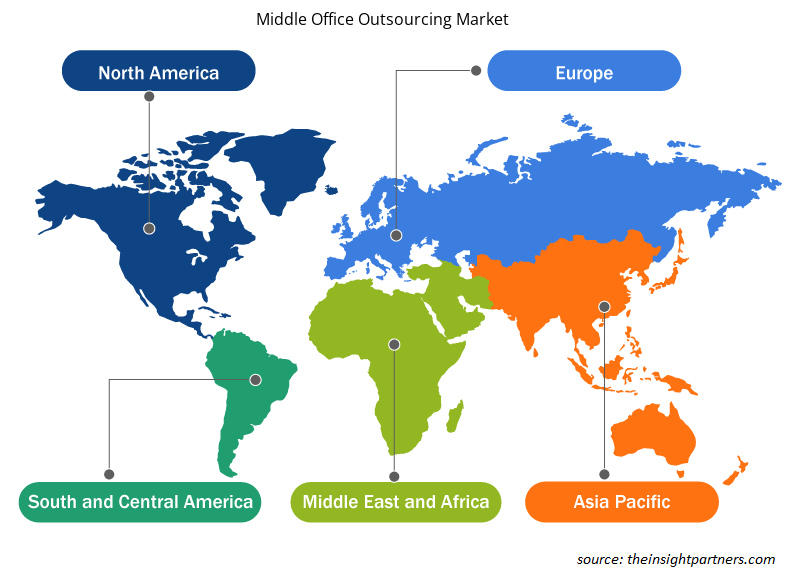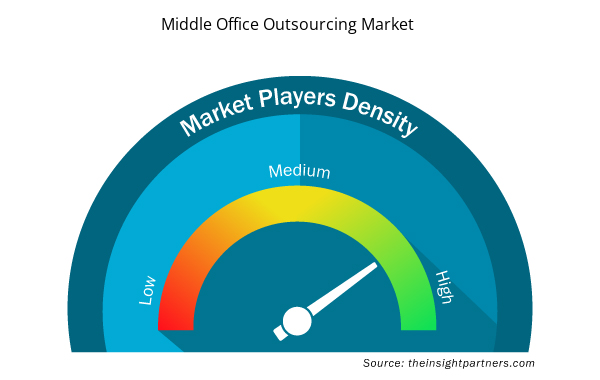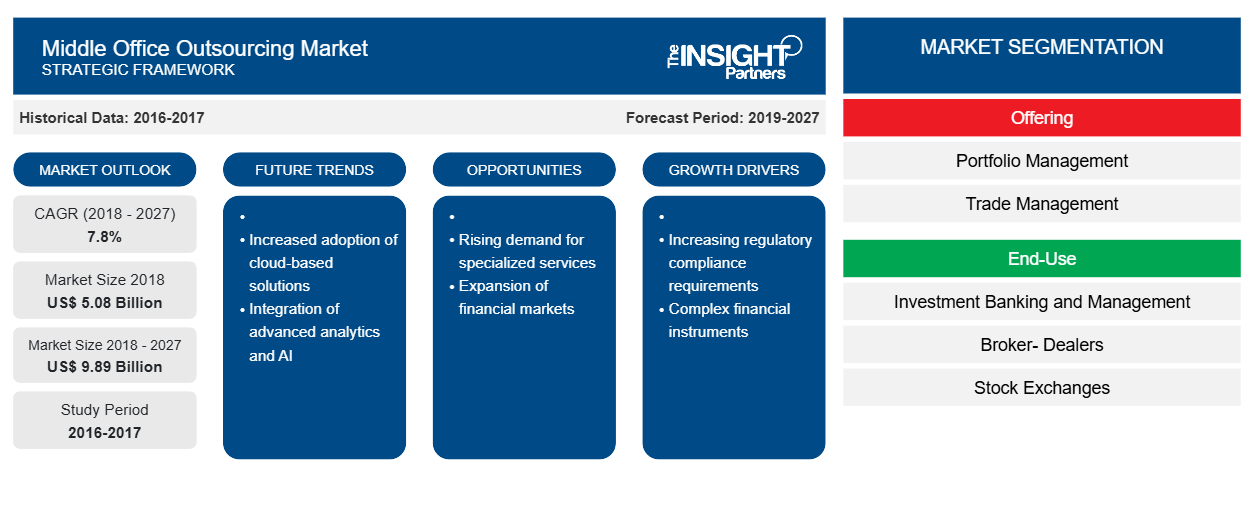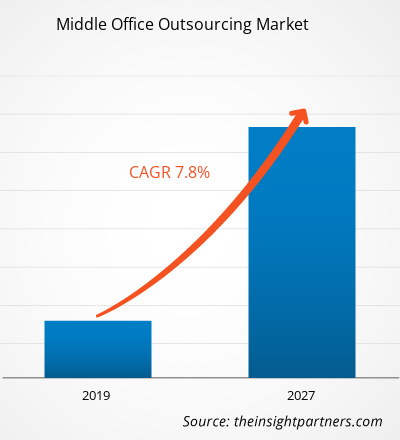Nel 2018 il mercato dell'outsourcing del middle office era valutato 5.084,1 milioni di dollari USA; si stima che crescerà a un CAGR del 7,8% per raggiungere i 9.894,7 milioni di dollari USA entro il 2027.
La crescente necessità di migliorare l'efficienza aziendale complessiva è uno dei principali fattori che guidano il mercato dell'outsourcing del middle office . Per soddisfare i requisiti di efficienza di un'organizzazione, i fornitori stanno attualmente proponendo servizi e offerte di prodotti innovativi. Si stanno anche concentrando sulla creazione di una pianificazione strategica allineata direttamente con le operazioni e le funzioni dell'organizzazione. I servizi di outsourcing del middle office aiutano ad allineare gli obiettivi aziendali con la pianificazione della gestione e quindi mantengono il coordinamento tra le diverse attività dell'organizzazione. Ad esempio, i costi associati al sistema bancario tradizionale possono essere ridotti esternalizzando i processi del middle office, come gli acquisti e le operazioni commerciali. Inoltre, per aumentare la quota di mercato e mantenere un vantaggio competitivo, gli operatori del mercato stanno proponendo nuove idee e introducendo molte nuove tecnologie e tecniche nei servizi del middle office. Inoltre, la manutenzione predittiva delle risorse introdotta probabilmente aiuterà le aziende nella riduzione dei costi di manutenzione, risparmiando denaro sulle riparazioni programmate ed eliminando eventuali guasti.
Personalizza questo report in base alle tue esigenze
Riceverai la personalizzazione gratuita di qualsiasi report, comprese parti di questo report, o analisi a livello nazionale, pacchetto dati Excel, oltre a usufruire di grandi offerte e sconti per start-up e università
- Scopri le principali tendenze di mercato in questo rapporto.Questo campione GRATUITO includerà analisi di dati che spaziano dalle tendenze di mercato alle stime e alle previsioni.
Approfondimenti di mercato
Ascesa dell'automazione e delle soluzioni cloud
L'ottimizzazione delle operazioni di middle office, come la riconciliazione dei report e la fatturazione, la contabilità di portafoglio, l'aumento del personale, svolge un ruolo cruciale nelle istituzioni finanziarie poiché l'outsourcing aiuta a superare i problemi relativi all'interruzione del flusso di lavoro e anche a salvaguardare da report errati. Pertanto, l'emergere dell'automazione è tra le tendenze chiave nel mercato globale dell'outsourcing di middle office. Elimina i processi non necessari, riduce i rischi operativi, fornisce informazioni preziose e riduce i costi. Inoltre, le soluzioni basate su cloud, come il "modello di middle office SaaS", vengono sempre più adottate per ridurre i costi operativi. L'emergere di soluzioni cloud e l'aumento dell'automazione probabilmente guideranno il mercato dell'outsourcing di middle office nel prossimo futuro. Le soluzioni di middle office basate su cloud aiutano a migliorare la flessibilità operativa fornendo aggiornamenti e miglioramenti frequenti, scalabilità on-demand ed estensibilità man mano che le aziende lanciano prodotti nuovi e innovativi.
Offrire approfondimenti di mercato
La gestione del portafoglio si riferisce al monitoraggio delle performance dei singoli titoli in un portafoglio azionario e all'esame del portafoglio per garantire che soddisfi le aspettative di crescita dell'investitore. La gestione del portafoglio e del trading aiuta gli individui High-net-worth (HNW) a gestire i propri asset finanziari in modo efficace e sicuro. Fornisce inoltre dati e analisi in tempo reale per prendere decisioni di investimento migliori e aiuta anche a migliorare le performance di gestione e ottimizzare l'agilità operativa. Con la crescente concorrenza nel mondo della gestione degli investimenti, vari investitori si stanno concentrando sui costi fissi associati. Gli investitori stanno anche sviluppando diverse strategie aziendali per prendere decisioni informate relative all'outsourcing di aspetti non essenziali della propria attività, come le operazioni di back-office o le funzioni di middle-office.
Approfondimento del mercato di utilizzo finale
I servizi di middle office coinvolgono vari stakeholder, vale a dire broker, depositari e altre terze parti. Per automatizzare il processo di flusso di lavoro e ridurre i costi/le spese complessivi, i clienti esternalizzano le loro operazioni di middle office, portando così a una maggiore necessità di servizi di outsourcing di middle office. In aggiunta a ciò, è difficile per le società di private equity e hedge fund diversificare i rischi patrimoniali e soddisfare le conformità normative a causa degli elevati investimenti e dei costi coinvolti. Pertanto, preferiscono esternalizzarlo a terze parti.
Gli attori che operano nel mercato dell'enterprise content management si concentrano su strategie quali fusioni, acquisizioni e iniziative di mercato per mantenere le loro posizioni nel mercato. Di seguito sono elencati alcuni sviluppi da parte degli attori chiave:
- A dicembre 2019, CACEIS e S3 trarranno vantaggio dalla creazione di valore, ottenendo un posizionamento competitivo e beneficiando di una maggiore presenza geografica, di una copertura completa della catena del valore dei servizi patrimoniali e di un'offerta ampliata per supportare sia i clienti esistenti che quelli nuovi nei loro progetti e nel loro sviluppo.
- Nel settembre 2019, Northern Trust ha lanciato una serie di nuove dashboard per i clienti di Omnium, la sua piattaforma tecnologica di middle e back-office per l'amministrazione di fondi alternativi.
Approfondimenti regionali sul mercato dell'outsourcing del middle office
Le tendenze regionali e i fattori che influenzano il Middle Office Outsourcing Market durante il periodo di previsione sono stati ampiamente spiegati dagli analisti di Insight Partners. Questa sezione discute anche i segmenti e la geografia del Middle Office Outsourcing Market in Nord America, Europa, Asia Pacifico, Medio Oriente e Africa e Sud e Centro America.

- Ottieni i dati specifici regionali per il mercato dell'outsourcing del middle office
Ambito del rapporto di mercato sull'outsourcing del middle office
| Attributo del report | Dettagli |
|---|---|
| Dimensioni del mercato nel 2018 | 5,08 miliardi di dollari USA |
| Dimensioni del mercato entro il 2027 | 9,89 miliardi di dollari USA |
| CAGR globale (2018 - 2027) | 7,8% |
| Dati storici | 2016-2017 |
| Periodo di previsione | 2019-2027 |
| Segmenti coperti | Offrendo
|
| Regioni e Paesi coperti | America del Nord
|
| Leader di mercato e profili aziendali chiave |
|
Densità degli attori del mercato dell'outsourcing del middle office: comprendere il suo impatto sulle dinamiche aziendali
Il mercato del Middle Office Outsourcing Market sta crescendo rapidamente, spinto dalla crescente domanda degli utenti finali dovuta a fattori quali l'evoluzione delle preferenze dei consumatori, i progressi tecnologici e una maggiore consapevolezza dei vantaggi del prodotto. Con l'aumento della domanda, le aziende stanno ampliando le loro offerte, innovando per soddisfare le esigenze dei consumatori e capitalizzando sulle tendenze emergenti, il che alimenta ulteriormente la crescita del mercato.
La densità degli operatori di mercato si riferisce alla distribuzione di aziende o società che operano in un particolare mercato o settore. Indica quanti concorrenti (operatori di mercato) sono presenti in un dato spazio di mercato in relazione alle sue dimensioni o al valore di mercato totale.
Le principali aziende che operano nel mercato dell'outsourcing del middle office sono:
- Servizi globali Adepa SA
- Fratelli Brown Harriman
- Cacio
- Parasiepi
- JPMorgan Chase & Co.
Disclaimer : le aziende elencate sopra non sono classificate secondo un ordine particolare.

- Ottieni una panoramica dei principali attori chiave del mercato dell'outsourcing del middle office
Segmenti del mercato globale dell'outsourcing di Middle Office:
Mercato dell'outsourcing del middle office – Offrendo
- Gestione del portafoglio
- Gestione del commercio
- Altri
Mercato dell’outsourcing del middle office – per componente
- Banca d'investimento e gestione
- Broker-Dealer
- Borse valori
- Altri
Mercato dell’outsourcing del middle office – Per area geografica
America del Nord
- NOI
- Canada
- Messico
Europa
- Francia
- Germania
- Italia
- Spagna
- Regno Unito
- Resto d'Europa
Asia Pacifico (APAC)
- Australia
- Cina
- India
- Giappone
- Resto dell'APAC
Medio Oriente e Africa (MEA)
- Arabia Saudita
- Emirati Arabi Uniti
- Sudafrica
- Resto del MEA
America del Sud (SAM)
- Brasile
- Resto del SAM
Aziende
- Servizi globali Adepa SA
- Fratelli Brown Harriman
- CACEI
- Parasiepi
- JPMorgan Chase & Co.
- Società di Trust del Nord
- Societe Generale Securities Services
- Società per azioni SS&C Technologies, Inc.
- Società di State Street
- La Banca di New York Mellon Corporation
- Analisi storica (2 anni), anno base, previsione (7 anni) con CAGR
- Analisi PEST e SWOT
- Valore/volume delle dimensioni del mercato - Globale, regionale, nazionale
- Industria e panorama competitivo
- Set di dati Excel



Report Coverage
Revenue forecast, Company Analysis, Industry landscape, Growth factors, and Trends

Segment Covered
This text is related
to segments covered.

Regional Scope
North America, Europe, Asia Pacific, Middle East & Africa, South & Central America

Country Scope
This text is related
to country scope.
Domande frequenti
Growing need to improve business efficiency, and budget constraints and increasing adoption of new technologies are among the factors expected to drive the middle office outsourcing market worldwide. The advent of big data analytics services and rise of automation and cloud solutions are among the factors that are anticipated to offer ample growth opportunities for the players operating in the middle office outsourcing market during the forecast period.
The portfolio management segment led the market in 2018. Factors contributing to the growth of portfolio management segment as it leads to savings by exercising three main levers, namely- Better Spend, Supplier, and Market Insights; Improved Ad Hoc Sourcing and Buying Performance; Increased Conversion into Bottom Line Savings.
Data analytics strategies are adopted for a wide range of functions, namely, quantitative research, trading analytics, risk simulation, modeling, and transaction cost analysis. Most of the enterprises, operating in the middle office outsourcing, have vast data due to the growing adoption of technologies and analytical tools. Thus, the advent of big data analytics services can offer huge opportunities for the growth of the middle office outsourcing market.
Trends and growth analysis reports related to Banking, Financial Services, and Insurance : READ MORE..
The List of Companies - Global Middle Office Outsourcing Market
- Adepa Global Services S.A.
- Brown Brothers Harriman
- Caceis
- Hedgeguard
- JPMorgan Chase & Co.
- Northern Trust Corporation
- Societe Generale Securities Services
- SS&C Technologies, Inc.
- State Street Corporation
- The Bank of New York Mellon Corporation
The Insight Partners performs research in 4 major stages: Data Collection & Secondary Research, Primary Research, Data Analysis and Data Triangulation & Final Review.
- Data Collection and Secondary Research:
As a market research and consulting firm operating from a decade, we have published and advised several client across the globe. First step for any study will start with an assessment of currently available data and insights from existing reports. Further, historical and current market information is collected from Investor Presentations, Annual Reports, SEC Filings, etc., and other information related to company’s performance and market positioning are gathered from Paid Databases (Factiva, Hoovers, and Reuters) and various other publications available in public domain.
Several associations trade associates, technical forums, institutes, societies and organization are accessed to gain technical as well as market related insights through their publications such as research papers, blogs and press releases related to the studies are referred to get cues about the market. Further, white papers, journals, magazines, and other news articles published in last 3 years are scrutinized and analyzed to understand the current market trends.
- Primary Research:
The primarily interview analysis comprise of data obtained from industry participants interview and answers to survey questions gathered by in-house primary team.
For primary research, interviews are conducted with industry experts/CEOs/Marketing Managers/VPs/Subject Matter Experts from both demand and supply side to get a 360-degree view of the market. The primary team conducts several interviews based on the complexity of the markets to understand the various market trends and dynamics which makes research more credible and precise.
A typical research interview fulfils the following functions:
- Provides first-hand information on the market size, market trends, growth trends, competitive landscape, and outlook
- Validates and strengthens in-house secondary research findings
- Develops the analysis team’s expertise and market understanding
Primary research involves email interactions and telephone interviews for each market, category, segment, and sub-segment across geographies. The participants who typically take part in such a process include, but are not limited to:
- Industry participants: VPs, business development managers, market intelligence managers and national sales managers
- Outside experts: Valuation experts, research analysts and key opinion leaders specializing in the electronics and semiconductor industry.
Below is the breakup of our primary respondents by company, designation, and region:

Once we receive the confirmation from primary research sources or primary respondents, we finalize the base year market estimation and forecast the data as per the macroeconomic and microeconomic factors assessed during data collection.
- Data Analysis:
Once data is validated through both secondary as well as primary respondents, we finalize the market estimations by hypothesis formulation and factor analysis at regional and country level.
- Macro-Economic Factor Analysis:
We analyse macroeconomic indicators such the gross domestic product (GDP), increase in the demand for goods and services across industries, technological advancement, regional economic growth, governmental policies, the influence of COVID-19, PEST analysis, and other aspects. This analysis aids in setting benchmarks for various nations/regions and approximating market splits. Additionally, the general trend of the aforementioned components aid in determining the market's development possibilities.
- Country Level Data:
Various factors that are especially aligned to the country are taken into account to determine the market size for a certain area and country, including the presence of vendors, such as headquarters and offices, the country's GDP, demand patterns, and industry growth. To comprehend the market dynamics for the nation, a number of growth variables, inhibitors, application areas, and current market trends are researched. The aforementioned elements aid in determining the country's overall market's growth potential.
- Company Profile:
The “Table of Contents” is formulated by listing and analyzing more than 25 - 30 companies operating in the market ecosystem across geographies. However, we profile only 10 companies as a standard practice in our syndicate reports. These 10 companies comprise leading, emerging, and regional players. Nonetheless, our analysis is not restricted to the 10 listed companies, we also analyze other companies present in the market to develop a holistic view and understand the prevailing trends. The “Company Profiles” section in the report covers key facts, business description, products & services, financial information, SWOT analysis, and key developments. The financial information presented is extracted from the annual reports and official documents of the publicly listed companies. Upon collecting the information for the sections of respective companies, we verify them via various primary sources and then compile the data in respective company profiles. The company level information helps us in deriving the base number as well as in forecasting the market size.
- Developing Base Number:
Aggregation of sales statistics (2020-2022) and macro-economic factor, and other secondary and primary research insights are utilized to arrive at base number and related market shares for 2022. The data gaps are identified in this step and relevant market data is analyzed, collected from paid primary interviews or databases. On finalizing the base year market size, forecasts are developed on the basis of macro-economic, industry and market growth factors and company level analysis.
- Data Triangulation and Final Review:
The market findings and base year market size calculations are validated from supply as well as demand side. Demand side validations are based on macro-economic factor analysis and benchmarks for respective regions and countries. In case of supply side validations, revenues of major companies are estimated (in case not available) based on industry benchmark, approximate number of employees, product portfolio, and primary interviews revenues are gathered. Further revenue from target product/service segment is assessed to avoid overshooting of market statistics. In case of heavy deviations between supply and demand side values, all thes steps are repeated to achieve synchronization.
We follow an iterative model, wherein we share our research findings with Subject Matter Experts (SME’s) and Key Opinion Leaders (KOLs) until consensus view of the market is not formulated – this model negates any drastic deviation in the opinions of experts. Only validated and universally acceptable research findings are quoted in our reports.
We have important check points that we use to validate our research findings – which we call – data triangulation, where we validate the information, we generate from secondary sources with primary interviews and then we re-validate with our internal data bases and Subject matter experts. This comprehensive model enables us to deliver high quality, reliable data in shortest possible time.


 Ottieni un campione gratuito per questo repot
Ottieni un campione gratuito per questo repot